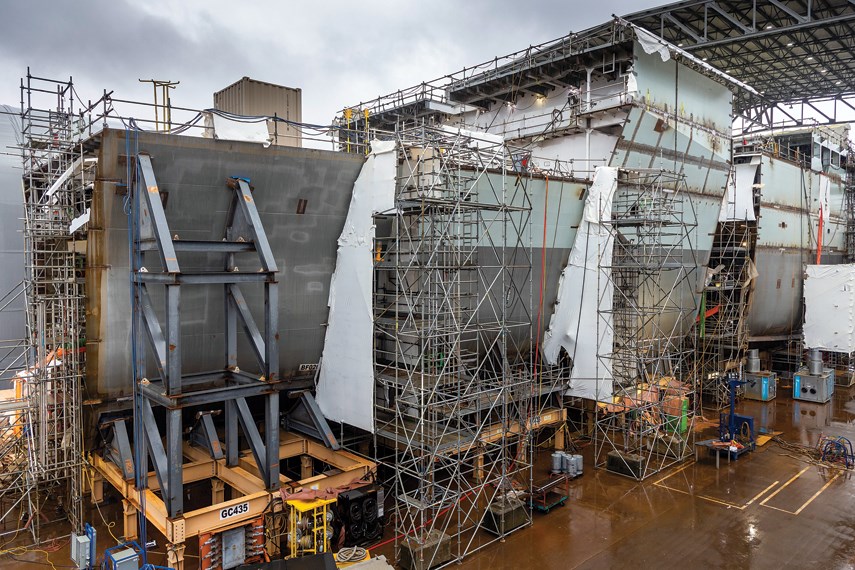North Vancouver’s Seaspan Shipyards will build one of two massive polar icebreakers for the Coast Guard, the federal government has announced.
The government announced Thursday it will build two heavy icebreakers – one each in North Vancouver's Seaspan Shipyards and the Quebec-based Chantier Davie.
Both new polar icebreakers will have capacity and ability beyond Canada's current largest icebreaker, the 62-year-old CCGS Louis S. St-Laurent, which the ships are intended to replace. The government has indicated it needs at least one of the replacement ships ready by 2030.
The news that two icebreakers will be built – rather than the one originally included in Canada’s national shipbuilding strategy – was a surprise, and follows two years of intensive lobbying by both shipyards.
Thrilling news for Seaspan
Amy McLeod, vice-president of corporate affairs for Seaspan, described the announcement as “fantastic” news for the local shipyard and its workers. “We’re thrilled and we can’t wait to get started,” she said.
When Seaspan modernized its shipyard a decade ago, it was purpose-built to accommodate the polar icebreaker, “because it is an incredibly complex large vessel,” said McLeod. “So it was always envisioned that a heavy polar icebreaker would be part of the non combat package. It’s just a great day to celebrate.”
North Â鶹´«Ã½Ó³»MP Jonathan Wilkinson described the announcement as good news for both the Coast Guard and for North Vancouver, noting Seaspan is one of the largest employers on the North Shore.
About 1,400 people are expected to work directly on the icebreaker while another 1,400 jobs are expected to be created in Seaspan’s supply chain, said McLeod.
Wilkinson said the contract will also set up Seaspan to “look at expanding its non-governmental shipbuilding business. I think it sets up the shipbuilding industry in a manner that will hopefully see it expand in a significant way going forward.”
A polar icebreaker was originally part of the non-combat package awarded to Seaspan in 2011. But two years ago, Ottawa took that off the company's order book – replacing it with a series of smaller multi-purpose vessels – and announced it was reopening bidding to include other shipyards, notably Davie Shipyard.
The announcement Thursday contained no budget details. One polar icebreaker was originally budgeted at $721 million and later, in 2013, estimated at $1.3 billion.
No budget details announced yet
Wilkinson said that information would be made public after construction contracts have been negotiated with the shipyards. He added negotiations with Seaspan are expected to begin very soon.
Wilkinson said the government is opting to build two icebreakers because the needs in the North are changing – there is more shipping traffic, including ships from other nations and "so a greater need to have a constant presence to demonstrate sovereignty," he said. The government is also doing more research in the North on climate change, he said.
Having two ships will allow for a Coast Guard presence in the Arctic for more of the year, he added.
So far it hasn’t been determined when the massive icebreaker will be started or finished at Seaspan.
The shipyard recently cut steel on a new offshore ocean science vessel, following the recent signing of a contract with the federal government to build the ship for $454 million. Delivery of that ship is expected in 2024.
Work on the ocean science vessel has started while construction on the first massive navy joint support ship is still ongoing at Seaspan. The first joint support ship is scheduled for completion in 2023. A second joint support ship is scheduled to be finished in 2025.
Timing of icebreaker construction an 'active conversation'
Wilkinson said Thursday that the timing of how the icebreaker fits into that schedule is “an active conversation” between Seaspan and the federal government.
It is anticipated that Seaspan will be the first shipyard to complete one of the icebreakers, he added.
B.C. Premier John Horgan issued a statement following the announcement, applauding the icebreaker decision.
"Bringing the design and construction of Canada's next polar icebreaker to B.C. shipyards recognizes that Seaspan has the know-how and capabilities to build it on the Coast Guard's critical timeline. This is a good day for our shipbuilding industry," said Horgan.
Horgan had lobbied the federal government to keep the icebreaker contract in B.C.
McLeod credited Seaspan’s workers for proving they were up to the task.
“They have earned this by sheer hard work and determination and full kudos to them and a huge shout-out because their performance brought this opportunity back to Seaspan and back to B.C.,” she said.



